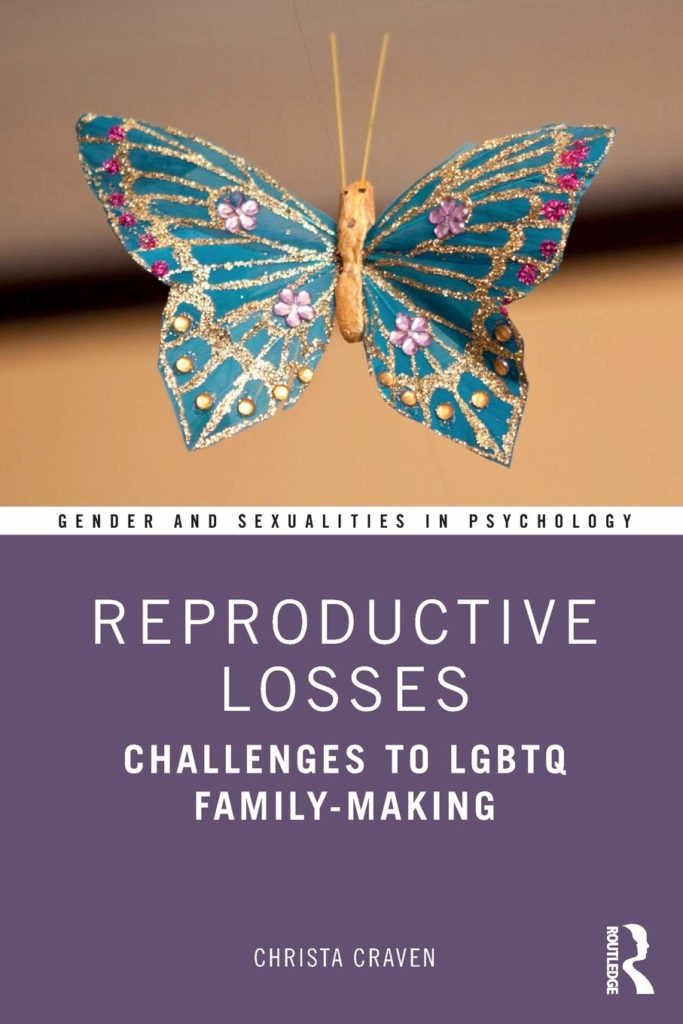Reviewed Book
Reproductive Losses: Challenges to LGBTQ Family‐making. Christa Craven, London: Routledge, 2019, 266 pp.
Reproductive Losses: Challenges to LGBTQ Family-making. Christa Craven, London: Routledge, 2019, 266 pp.

Erica van der Sijpt
University of Amsterdam
With Reproductive Losses: Challenges to LGBTQ Family-making, Christa Craven aims to break the silence around, and provide intimate insights into, the experiences of LGBTQ people with pregnancy loss, adoption loss, infertility, and sterility. In a context in which queer family-making efforts are both celebrated within a narrative of linear progress and continuously threatened by conservative forces, the losses and challenges that LGBTQ people may experience along the way are often rendered invisible. In her book—as well as the companion website (www.lgbtqreproductiveloss.org)—the author foregrounds detailed personal stories of loss, drawing attention to the complexity and diversity of such experiences. In doing so, Craven provides a key resource for academic and clinical researchers, LGBTQ people themselves, and the professionals, family members, and friends who are in close contact with them.
The book draws on in-person and phone interviews conducted between 2011 and 2018 with 54 LGBTQ people in and from the United States trying to form different family constellations, and representing various racial, socioeconomic, and religious backgrounds. With more than half of the research participants being non-gestational parents and about one-third identifying as people of color or mixed race, the study innovatively includes the voices of those generally underrepresented in existing studies of reproductive loss and/or queer family-making. Focusing on different forms of reproductive misfortune—all captured under the umbrella term of “reproductive loss”—it further counters the tendency to artificially separate experiences of loss, and instead allows for the discovery of commonalities across cases.
As a feminist anthropologist and queer parent who has experienced loss herself, Craven approaches this search for commonalities with a clear agenda. One of her main aims is to offer a “queer” reading of reproductive loss, by showing how the multiple meanings and implications of loss extend beyond individual reproduction and family-making. The author proposes to take a “reproductive justice approach” to reveal and challenge how LGBTQ experiences of loss are largely shaped by heteronormativity and cultural silence, and intersect with race and class as people’s access to resources is clearly stratified. At the same time, she intends to highlight the creativity and resilience that differentially positioned LGBTQ people may display after their loss.
The six empirical chapters that form the core of the book are each meant to contribute to these insights in different ways. The first chapters (Chapters 4–7) present the various societal challenges and forces that LGBTQ people encounter when their reproduction goes awry, and that set their experiences of loss apart from those of heterosexual people. First, as serious emotional, physical, and financial investments are needed when trying to create a LGBTQ family in the United States, any form of loss in this process can be particularly painful; since, for many, “trying again” is not a straightforward, attainable, or desirable option, such a mishap often implies the loss of any hope for family formation. Second, experiencing reproductive loss generally also means having to deal with homophobia, heterosexism, racism, religious ideology, economic precarity, and/or legal barriers. These intersections render LGBTQ reproductive losses complex events that invariably link intimate personal experiences to wider political agendas and social inequalities. Third, after their loss LGBTQ people struggle to find resources and forms of support that are attuned to their particular needs, situations, and identifications. The general lack of societal acknowledgment of queer loss exacerbates their sense of personal and political isolation.
Against the backdrop of these struggles, the last empirical chapters (Chapters 8 and 9) highlight the resilience and promise that may surface when attempts to build a family fail. The stories in these chapters illustrate how LGBTQ people often resort to meaningful individual coping strategies, commemoration practices, and forms of community support when dealing with the impact of their reproductive loss. Offering a queer reading of grief, Craven argues that mourning should be seen as an integral and creative part of LGBTQ family-making. Together, these empirical insights inspire a short concluding chapter reiterating the author’s activist stance and efforts to draw attention to the specifics of LGBTQ reproductive loss via the book and the companion website.
The book’s strength is the rich empirical evidence collected by Craven. However, as the analysis of the presented narratives is purposefully kept to a minimum—since the author chose to make these texts available to a broad audience for their own interpretation—some academics may find the book lacking in theoretical depth and nuance. For instance, Craven’s repeated claims about suppression and discrimination could have been strengthened with a more nuanced approach to the full range of experiences brought forward by the interviewees. Moreover, the strong emphasis on fundamental differences between LGBTQ and heterosexual losses—running through both the original interviews and all empirical chapters—precludes a more nuanced analysis of possible parallels between the two. Nonetheless, given the novelty and detail of the experiences described, this book is a valuable addition to the existing body of literature on (LGBTQ) reproductive health and family-making. The rich illustrations of the efforts, emotions, and navigations around reproductive loss will also be an important resource for LGBTQ people trying to make sense of their own reproductive losses, or for anyone dealing with them in a professional or personal context.